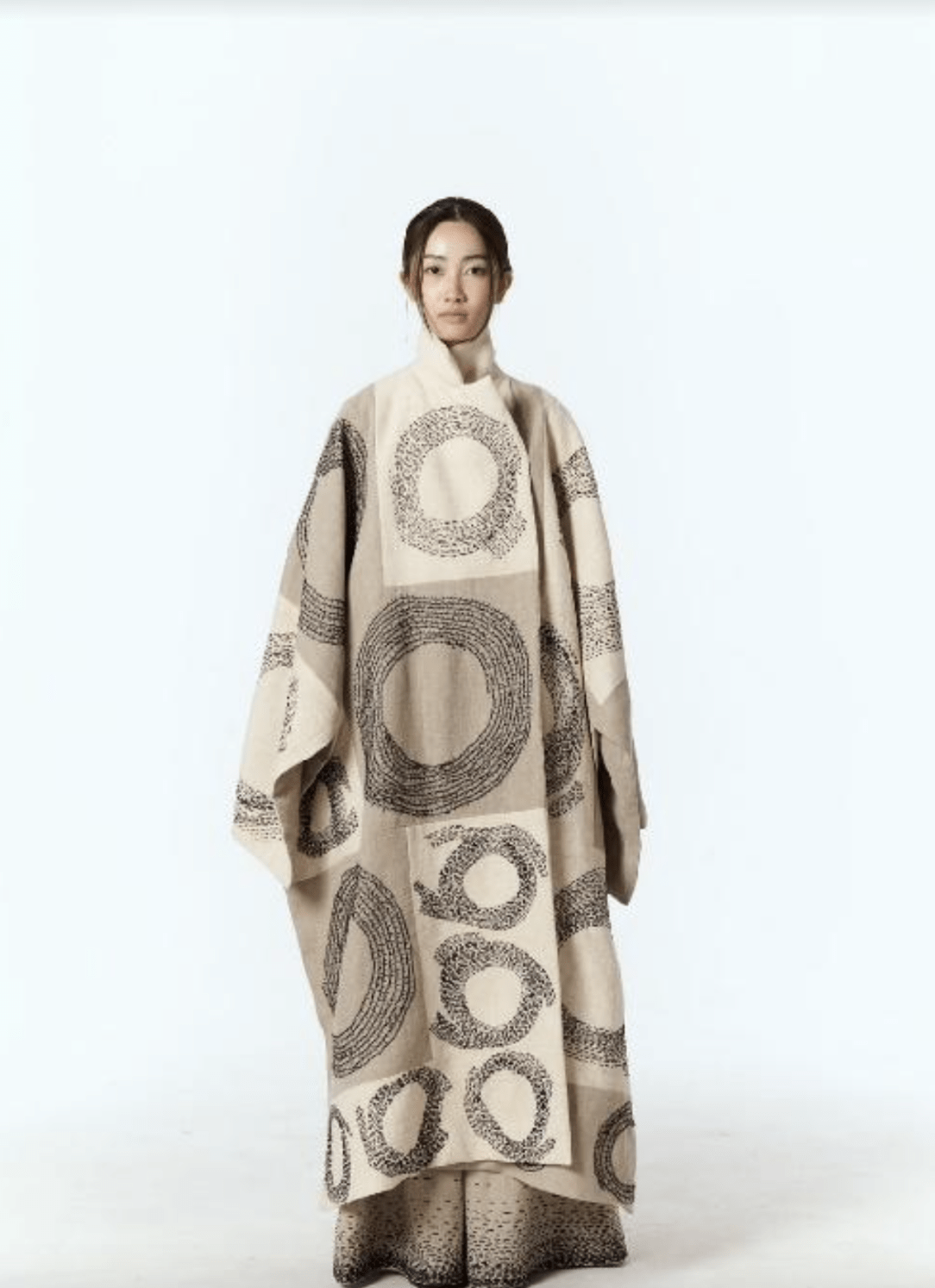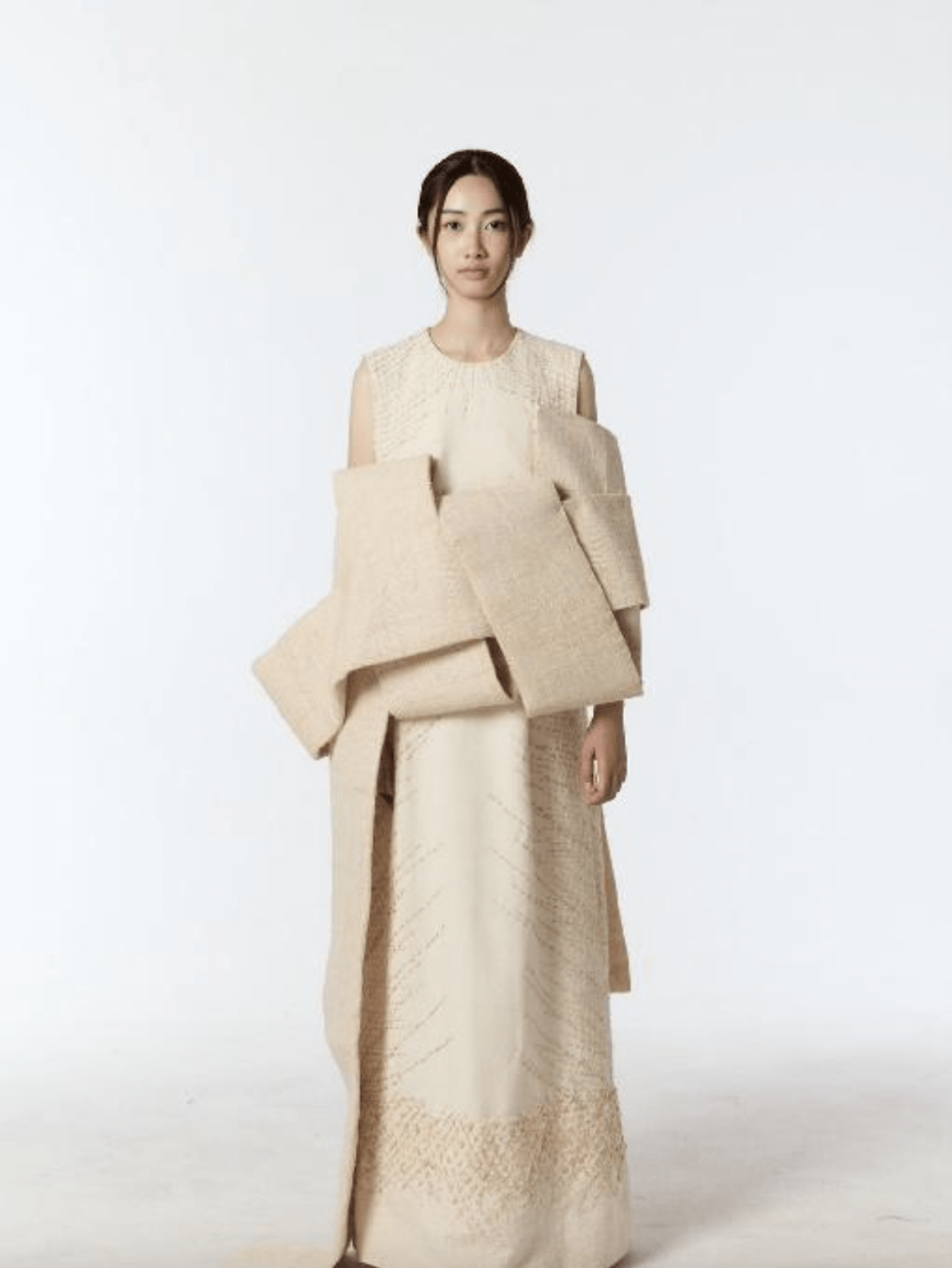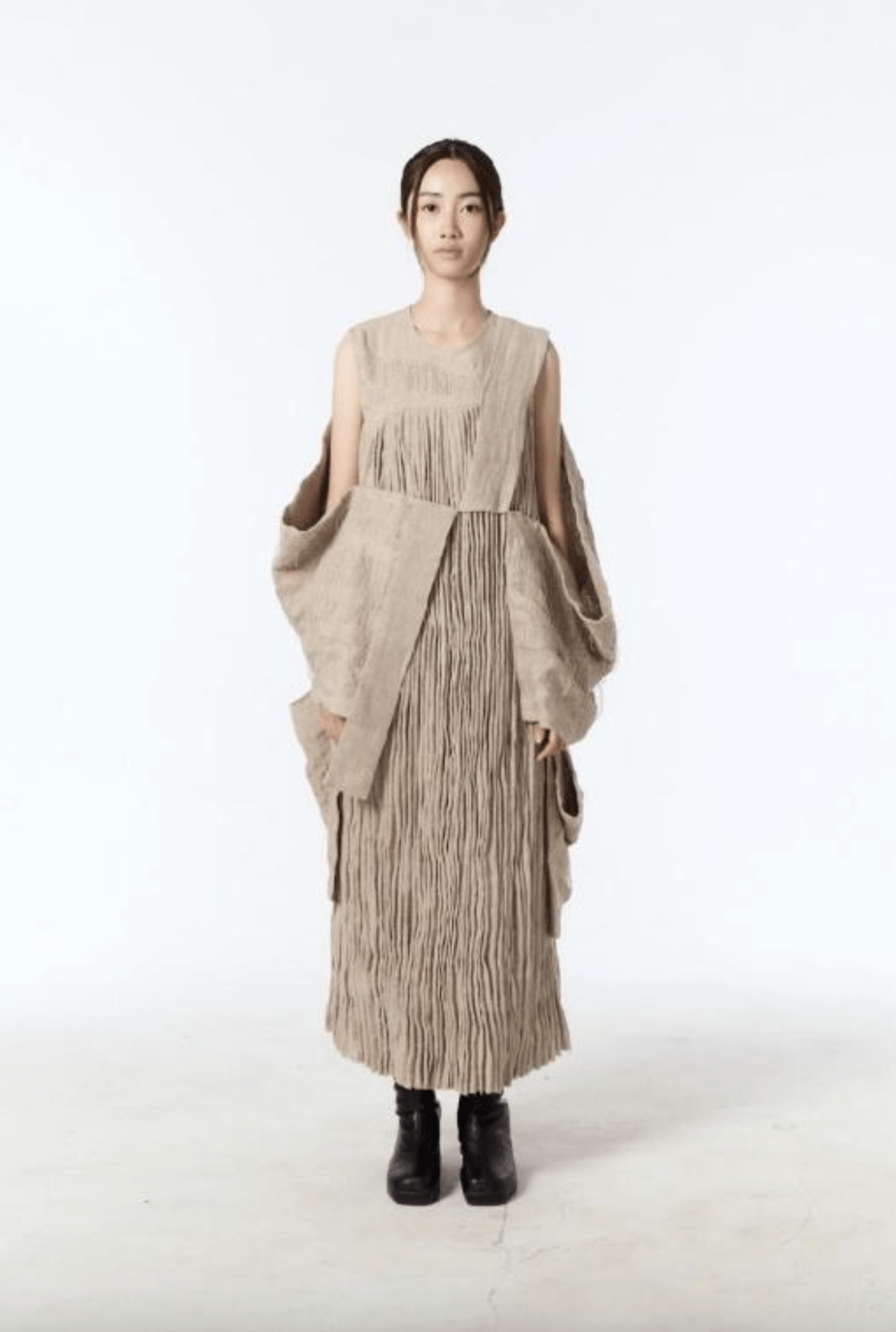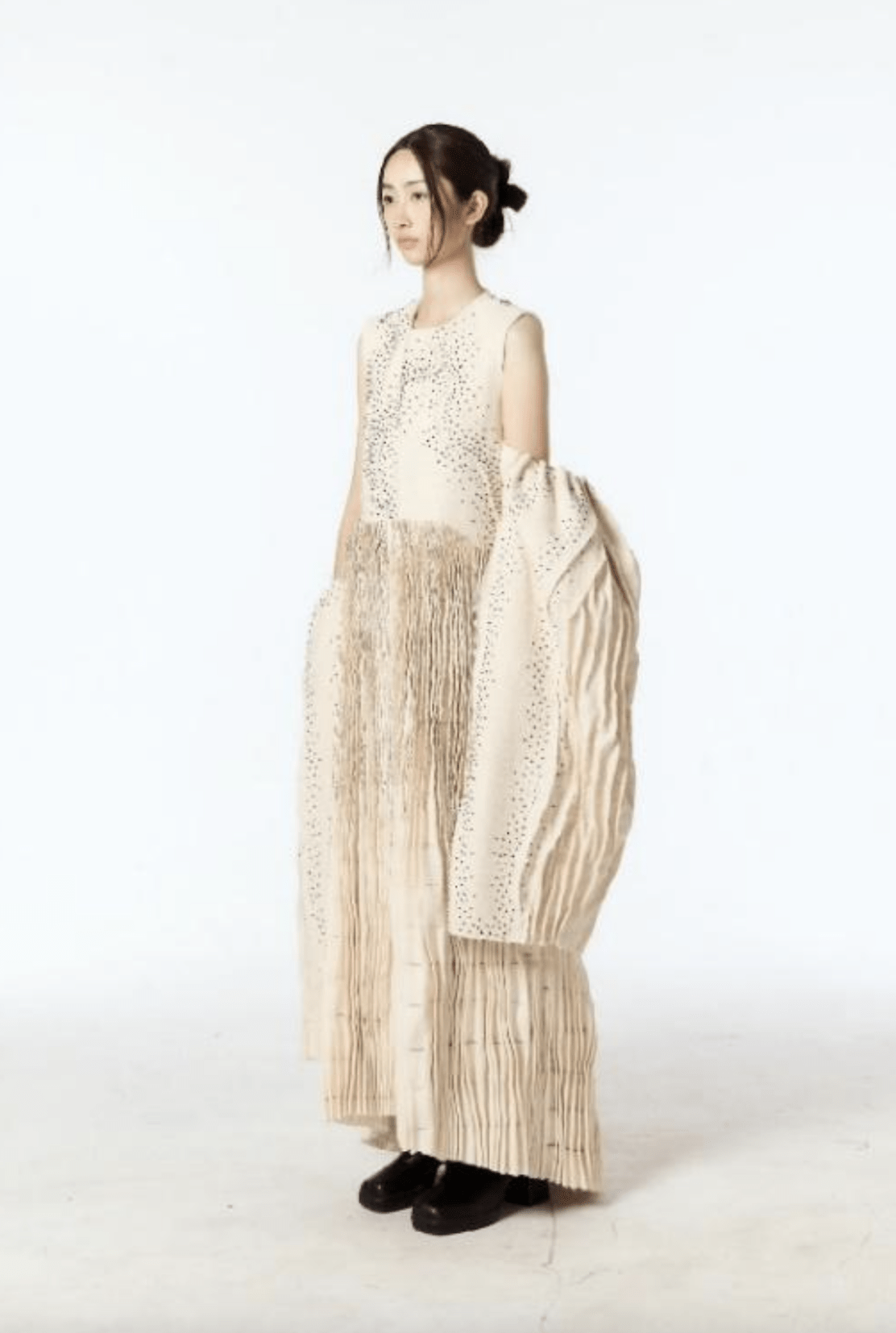
Asst. Prof. Supreeya Sutthamtarikul




Abstract :
The study of Wabi-Sabi, Japanese aesthetics, is used in this creative fashion research. Understanding of “Impermanence and no-self” make living a humble life known to the Japanese people. Causing the aesthetics of “Wabi-Sabi” has created culture, aesthetics, art and way of Life. Studying the art of “Zen” which is the practice of meditation by drawing circles or Ensō is an important result. Ensō images bring out the simplicity of nature, transient, impermanent and imperfect. In addition, some concepts from Sabi also refers to the desolation or stains of things, which later evolved into the concept of Suki with its refined image and has a unique style. In addition, studying the haiku poems of Matsuo Basho supports “appreciating the beauty of things that pass time” as well.
In creating this collection has used the symbol, derived from the literature of Murasaki Shikibu. The inspiration of Japanese men’s and women’s clothing, Mino (straw robes) and paintings of clothing from the Marunomachi period were selected. Applied to create silhouettes in contemporary clothing. Japanese clothing and techniques: Kintsugi; Boro; Sachiko; and torn clothes, were also used to experiment with designs. Based on the concept of Wabi, Sabi and Suki; Kintsugi, Shibusa and Mujo are used to create the collection. the objective of this creation is to create austere, irregular, unfinished, and imperfect looks. Including the use of natural colored hand-woven fabric to clearly show that “The profound beauty of things that pass time.”
This collection is created for particular target group with their positive attitude towards fashion in having a habit of consuming products that use Thai woven fabric. It also includes benefits that will lead to Bann Tub Kaew Kham Weaving Community Enterprise, Serm Ngarm District, Lampang Province, as well as writing a text book.
Objectives :
3.1 To further study and research about Wabi-Sabi philosophy. Emphasizing the “Sabi” approach
3.2 To further study and research the works of Japanese designers using the “Sabi” method
3.3 To analyze things that have passed through the passage of time, and experiment with textures with techniques for Kintsugi (repairing), Boro and Sashiko
3.4 To analyze concepts “Beauty that passes through the passage of time” and experimenting with clothing silhouettes
3.5 To design the collection according to the experiment. “Beauty that has passed through the passge of time from the aesthetics “Wabi-Sabi”
Conceptual Framework :
In Basho’s “haiku” poems, a simple aesthetic is found. It is one of the important concepts of Wabi-Sabi philosophy. Similar to the concepts of Kintsugi (repair), Shibusa (nature, uneven, unfinished, imperfect) and Mujo (impermanent, no-self) are used in this creation. Especially, Sabi can be interpreted as “Appreciating the beauty of things that pass time” (Outfit#2 and Outfit#3) including the concept of “Suki” which Sabi is developed to look more exquisite and simple. It is therefore used in some looks (Cloak #1 and #2, Outfit #1), which represents the evolution of Sabi. That is desolation and traces. Shows the meaning of the loneliest mood (set 3). When connected to Buddhism, it means peace. In addition, Zen art “Enzo” is an art that comes from training the mind to be calm. brings simplicity Imperfect, impermanent, incomplete and natural. which can be interpreted from the color of the brush (Cloak #2). Ultimately, the conclusion of Wabi-Sabi philosophy is exactly the same as Enzo’s.
Process / Methodology :
This research is a theoretical practice using the concept of Wabi-Sabi philosophy. In the process of working on “Appreciating the beauty of things that pass with time” through structure and texture. “Wabi” means simplicity. humility and “Sabi” represents loneliness and desolation.
design process. The capsule collection is contained 5 items.
Cloak #1
The Black Overcoat is inspired by the layered silhouette of the “Mino” (Japanese raincoat). The surface design is inspired by rice straw, Mino’s material. The cloaks symbolize Suki and Shibusa and replaced with gathering fabrics with simple stitch.
Cloak #2
The off-white cloak was inspired by the imperfect Japanese kimono, experimenting with drawing “Ensō” and creating a repeating pattern design. Boro, Sachiko and Kintsugi techniques to symbolize Sabi. The opened the side seams symbolize incomplete.
Dress #1
The white dress is made from handwoven pineapple fibers and cotton, symbolizing the complexity of Wabi-Sabi. This outfit is inspired by the kimono and obi. and shows the difficulty to unfold Wabi-Sabi. Simple stitching with pineapple yarn conveys the shadow of the garment. It shows Shibusa and a simple structure, interpreting Suki.
Dress #2
Gray dress made from hand-woven hemp fabric, which is inspired by Japanese clothing culture. When a samurai is working or fighting, he usually takes off his shirt on one side, and the embroidery using the technique of tearing clothes is a symbol of the Sabi, showing impermanence and imperfection
Dress #3
White dress made of handwoven cotton, surface design and silhouette of the garments are Sabi’s look. The structure of the dress is inspired by the torn men’s kimono. for surface design, unfinished embroidery using simple hand stitches. It represents loneliness and desolation.
This collection is applied and using concepts from “Appreciating the Beauty of Things that Have Passed the Passage of Time” which comes from the aesthetics of Wabi, Sabi, and Suki.
Techniques and Materials :
Choosing the Boro and Sashiko and the Kintsugi (Kintsugi) technique, which are patching and simple techniques were applied for decoration. For materials, three types of materials were chosen: hand-woven cotton in natural colors, pineapple woven fabrics and hemp woven fabrics.
“Boro” (Bryant. Aug 31, 2015) is a Japanese tradition of repairing fabric or the form of “patchwork” or joining fabric. This mending came about out of necessity in the lives of farmers when their clothes were torn. It inevitably had to be repaired and had the opposite effect on The Japanese have created blankets made using the Boro technique, they was used in hot weather in the past. It is Japanese woven fabrics that are sewn together and become thicker and thicker until the first piece of cloth could not be seen, that is the origin. What happened in the first place, the torn cloth was covered with cloth dyed with various colors of indigo.
“Sashiko” (Sashiko, Muzquiz, Albert. Mar21, 2018) The origin of the Sashiko technique, found in the history of ancient fabrics of farmers, it has the appearance of simple hand sewing. Stacking fabric to make it thicker which are used in the winter and as decorations for clothes used in daily life. The Japanese admire imperfect beauty of their own rural fabric.
Kintsugi or Kintsugi art (Marumura, May 11, 2018) has concepts that reflect the Zen Buddhism. In the way of Wabi-Sabi, it is the way of imperfection, simplicity and accepting one’s identity and mistakes. As well as the traces of brokenness that occurred, it helps reflect what has been experienced, and accept what has happened along with being able to continue living life happily
Result / Conclusion :
7.1 Results of the study of Wabi-Sabi philosophy in this research are further studies of Sabi and Zen aesthetics. This includes the study of the Wabi-Sabi philosophy that evolved into the Suki concept, which is the principle of developing the image of the old stain of the past. Also, there are studies on the work of Rei Kawakubo’s Com des Garcons emblem, as evidenced by the description in a 2018 exhibition at “Modern Art Metropolitan Museum.” It was confirmed that she used the “Wabi-Sabi” philosophy in designing some of the collections.
7.2 The use of symbols from the Tale of Genji (Supreeya, 2019) is used in storytelling. There are symbols of tying, untying, torn fabric, Sashiko (simple sewing), fabric joining(patchwork), Kimono frame, Mino raincoat have been applied and represented. Stains of oldness, decay, and deterioration over time, which is creatively exquisite.
It’s crafted to be meticulous. The main concept is to appreciate the beauty of things that have passed through time.
7.3. Hence, Sabi’s concepts are about feelings of loneliness, hopelessness and poverty. These are all negative thoughts, but they have an underlying meaning of positive thoughts linked to Buddhism. As a guideline for this collection was created, it uses Suki’s concept to develop an image of hopelessness turns into a neat and simple contemporary fashion image in some outfit.
References :
Boro. (No date) Retrieved from https://www.heddels.com /August32,2015/all about boro the Japanese patchwork/
Ensō (No date) Retrieved from https://en.wikipedia.org/wiki/Ensō#/media/File:Enso.jpg
Japanese clothing. Retrieved from https://en.wikipedia.org/wiki/Japanese_clothing
Japanese textiles Retrieved from https://onestitchattime.files.wordpress.com/2013/05/japanuese-textiles.jpg
Japanese warriors. Retrieved from https://www.alamy.com/stock-photo/japanese-warriors.html?page=3&sortBy=relevant
Kepton, Beth.2018. WABI SABI Japanese Wisdom for a Perfectly Imperfect life. London: Piatkus. pp. 236
Koren, Leonard.1994. Wabi-Sabi for Artists Designer Poets and Philosophers. Berkeley: Stone Bridge. pp.95
Marinucci, Lorenzo. 2018. Retrieved from Sabi and irony. The cross-cultural aesthetics of
Ōnishi Yoshinori. Studi di estetica anno XLVI, IV serie, 1/2018 ISSN 0585-4733, ISSN digitale 1825-8646, DOI 10.7413/18258646046
Matsunobu, Koji. (No date) “Art of Simplicity: Teaching Japanese Spritual Arts. Retrieved from Art_of_simplicity_Teaching_Japanese_spir.pdf Chapter 21, p.139
Whitfield, Danielle. (No date) Retrieved from https://www.ngv.vic.gov.au/collecting-comme/rei-kawakubo-reframing-fashion/
Tenji, Itoh. 1993. Wabi Sabi Suki. The Essence of Japanese Beauty Tokyo: Cosmo Public Relations Corps.